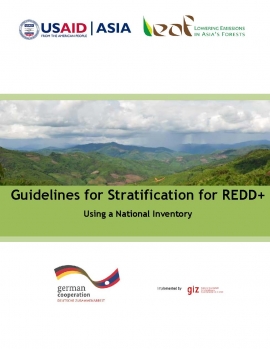Guidelines for Stratification for REDD+: Using a National Inventory
-----------------
 Engaging in REDD+ and seeking to take part in the opportunities and benefits of REDD+ requires credible scientifically-based estimates of emissions and removals of greenhouse gases from human-induced activities that change the cover and use of forest lands. This means data have to be collected on the extent of areas affected by human-induced activities that promote land cover change. The focus of this report is to provide step-by-step guidance on stratifying the forested landscape to facilitate the design of cost effective field sampling plans for measuring forest carbon stocks.
Engaging in REDD+ and seeking to take part in the opportunities and benefits of REDD+ requires credible scientifically-based estimates of emissions and removals of greenhouse gases from human-induced activities that change the cover and use of forest lands. This means data have to be collected on the extent of areas affected by human-induced activities that promote land cover change. The focus of this report is to provide step-by-step guidance on stratifying the forested landscape to facilitate the design of cost effective field sampling plans for measuring forest carbon stocks.
To measure forest carbon stocks, the forestland undergoing human-induced changes need to be sampled. Because not all forests are equal in composition, structure and carbon stocks, the focal forest lands, hereinafter referred to as the population of interest, must be stratified into sub-populations, or strata, that form relatively homogenous classes with similar carbon stocks. Stratification increases the precision of carbon stock estimates as it diminishes the sampling effort necessary, while maintaining the same level of confidence, because of smaller variation in carbon stocks in each stratum than in the whole area.
In the situation where a national inventory already exists, the purpose of stratification is to optimally divide forest areas between areas with carbon stock similarity. The divided areas will incorporate inventory plots, and with a good stratification high precision will result and consistent pairing will be possible with respective activity data.
The purpose of this report is to provide a user-friendly sequence of steps guiding the stratification process for the development of accurate and statistically rigorous estimates of forest carbon stocks.
The set of steps depend on availability of data and encourages the use of existing national forest inventory data. The stratification process starts at a coarse global level classification, and through a series of steps, it narrows down to local expert knowledge of the forested landscape. The ultimate goal is to develop forest strata with little variability in carbon stocks.
---------------

